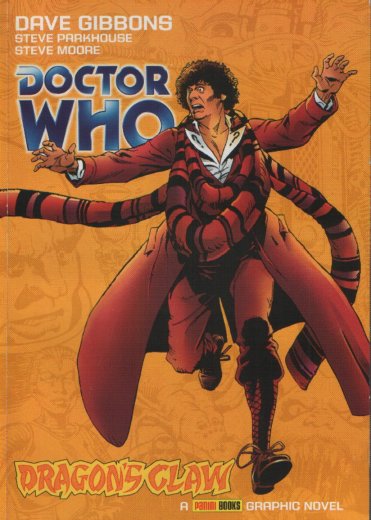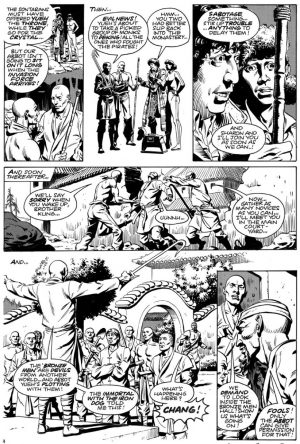Review by Tony Keen
This second collection of Marvel’s comics about Britain’s favourite time-traveller picks up where The Iron Legion left off, and brings together the remainder of the strips featuring Tom Baker’s Fourth Doctor. These were originally published from 1980, ending in January 1982, just as Baker was replaced on the television screen by Peter Davison.
Art throughout is by Dave Gibbons, apart from one two-part story drawn by Mike (aka Mick) McMahon. Gibbons is very much at his best here, and it is some of the most attractive art of his career (see sample image). He captures Baker’s face nicely, and produces dynamic images and layouts for the stories. McMahon’s artwork is very different, but equally attractive in its own way.
The first stories are written by Steve Moore, who took over at the end of The Iron Legion. He begins with the title story, that seven-part adventure the longest sustained narrative found here, after which the stories are rarely more than an episode or two in length. At the end of ‘Dreamers of Death’, Moore gets rid of Sharon, the companion Pat Mills and John Wagner introduced for the Doctor, and subsequently plays down the role of the Doctor’s robot dog K-9 (also being eliminated from the TV series at the same time). Instead of having a companion, the Doctor will sometimes articulate the plot through talking to himself or the use of thought bubbles, though often the Doctor will meet somebody early in the story who will become his principal interlocutor, acting essentially as a one-off companion. Midway through this run Moore is replaced by Steve Parkhouse, but the style of the strip changes very little. What Parkhouse does is introduce Doctor Asimoff and the Free-Fall Warriors, who would prove popular enough to return later.
Doctor Who being able to travel through time and space is an excellent concept, able to accommodate a wide variety of approaches. That said, it needs to be mentioned that, as with the previous volume, Moore’s and Parkhouse’s stories don’t quite feel like television Doctor Who of the time. Neither quite manages the authentic voice of Tom Baker’s Doctor’s via the dialogue, and the milieu in which the Doctor operates is more like that of 2000 AD. A few stories (‘Spider-God’, ‘The Deal’, and ‘End of the Line’) have downbeat endings that it’s hard to imagine the BBC of the time allowing to be broadcast.
In the end, how much you appreciate these stories will depend on which direction you approach them from. If you are a Doctor Who fan, wanting new stories featuring your favourite Time Lord, you may find these tales a little disappointing. On the other hand, if you want innovative science fiction short stories, produced by two writers at the top of their game, this volume is rather more satisfactory.
The reprint series continues with The Tides of Time, covering Marvel’s Fifth Doctor stories. IDW later acquired the license, and produced several volumes. All this material, except the McMahon story, can be found in Doctor Who: Dave Gibbons Collection, and is additionally scattered across Doctor Who Classics volumes 1-4 (and consequently in Doctor Who Classics Omnibus volumes 1 & 2). In 2023 the all-encompassing Doctor Who: The Fourth Doctor Anthology gathered all Marvel UK Tom Baker stories.





